Scoring Elusive Archives: Mapping the Traces of Disco Comradeship
I. Introduction
Megan Hoetger and Carlos Kong
[1]Throughout our five months together, the Archiving Club Cultures from Late Socialism through the Era of ‘Social Distancing’ workshop wove together methodologies that intersected political theories of socialism and comradeship, the visual cultures of the Eastern Bloc, art and film histories of East Germany, urban anthropologies of the post-socialist and neoliberal city, and performative and activist approaches to nightlife, anti-gentrification, and collectivity.
Our workshop began with an introduction to the concept of ‘Disco Comradeship’ elaborated by workshop conveners Megan Hoetger and Carlos Kong. Developed from Hoetger and Kong’s archival research at The Whole Life Academy Dresden in 2019, ‘Disco Comradeship’ is a curatorial framework that encompasses the collective practices of film, nightlife, and urban space from Cold War-era state socialism up through the present—and in the context of our workshop, from former East Germany through post-socialist and contemporary Germany.
The conceptual scope and archival materials of our workshop were enriched by collaborations with guests: the curator and theorist Doreen Mende, the art historian and curator Susanne Altmann, and Wanda Gaimes, co-founder of the queer-feminist rave collective Lecken. Throughout these sessions, various methods and practices were presented and discussed, including Mende’s theoretical and visual cultures approach to ‘decolonizing socialism’ by reading East German films and archives against the grain; Altmann’s art historical attention to ‘feminist collective praxis’ in the unofficial art scenes of East Germany as co-curator of Hösen haben Röcke an. Künstlerinnengruppe Erfurt 1984-1994 at ngbk in Berlin, which our workshop visited in-person and digitally; and Gaimes’s collective practice of ‘critical rave’ that entwines nightlife with activism.
As our workshop engaged various archival materials—critical writings on comradeship, the ‘disco films’ of DEFA, a collectively-authored PhD in film practice from 1970s East Germany, the experimental films of the Erfurt Women Artists’ Group, records of film screenings, the historical traces present and absent on city sidewalks, and contemporary dance parties—and moved across the historical and political perspectives of their methods, this set of questions remained constant:
What does it mean to do archival research in embodied ways? Where is ‘the archive’ located in such an approach? And how might the open form of ‘the score’—a provisional map, a musical or performance score, a speculative cartography, an image atlas, a set of instructions—offer possibilities for articulating and transmitting the knowledge of elusive archives?
The six scores are works-in-progress created by our workshop participants. They traverse a wide range of topics, from Aikaterini Gegisian’s imaginative charting of Eastern Bloc print culture to Mattia Capelletti’s protocols for listening; from Sabine Willig’s song-based map of present-day Neukölln to Lalu Özban’s video portrait of gathering under pandemic conditions in Istanbul; and from Sterre Barentsen’s tracings of urban community garden projects in Pankow in the 1970s to Pablo Santacana López and Daniel Schneider’s cartography of clubs in the same historical streets of East Berlin.
- This contribution is published as the workshop findings of “Archiving Club Cultures from Late Socialism through the Era of Social Distancing”. The workshop was convened by Megan Hoetger and Carlos Kong and took place online from October 2021 – March 2022 as part of the Whole Life Academy Berlin. ↑
II. GLOBALALIA Listening Protocol
Mattia Capelletti
The voice has always been the raw material of political participation, as the nexus of the body – carrier of individual experiences and collective histories – and language, through which we articulate our demands. Since its deliberative beginnings in Ancient Greece, the public space of democracy has imagined itself as an acoustic arena. Listening to the soundscape of the agora, where the disputes for “the public thing” were played out dialogically between cogent orators, one soon realizes that the voices in conversation sound too much like the same – the animal’s call; the barbaric gibberish of the foreigner; childish babble; women’s “subsensical” gossip; the silence of the deaf and mute and that (alternated to screams) of the slaves: all constituvely excluded from the aural-political spectrum. Articulated vocally, political participation should sound like a dissonant choir – a “globalalia” – but too often recalls a sequence of solos, surrounded by deafening silences. The current neoliberal version of democracy updates this system of exclusion, intensifying individualities and automatizing mishearings. It does so primarily by forcing an unnatural identification of its political subjects with their own voices. It posits, as Fred Moten and Stefano Harney suggest, “having a voice” instead of “hearing voices”. We participate in the work of silencing when we patrol the thresholds of audibility under which listening does not make sense: voices deemed too feeble, loud, vulgar or unarticulated – literally in-comprehensible into the community of “reasonable” speakers. We bring this disciplining into the safe spaces we build for resistance when a comrade comes to be understood exclusively as one who speaks our language: when “in a purely discursive understanding of politics,” as Maan Abu Taleb reminds us, we forget “what the revolutionary is”. We do the job of acoustic border control when we fail to recognize voices — but also through the excess of identification: like the German Federal Migration Office (BAMF), which decides on asylum seekers’ lives by way of an automated accent recognition software based on a narrow (as much as scientifically inconsistent) understanding of the human voice, and a racially biased archive of “meaningful” voices. But out in the streets, any contemporary Western city provides a broader archive of voices than a system like that in use at BAMF. As a matter of fact, any given individual always already contains a multiplicity of voices and polyphonic desires, oscillating between legibility and noise.
To expand our field of listening we must pass through this cacophony, fluctuate between the murmur of the crowd and the individual timbre, if only to understand the singular voice as itself a multitude. This mode of listening might perhaps be one way to decolonize, depatriarchalize our hearing, or, at least, to make us reflect on how we listen. It proposes an exercise for decoupling our ingrained listening habits from the impulse to understand and identify, on which the neoliberal notion of inclusion is based. It aims to extend the aural spectrum not by addition (in this sense it refuses, or overturns, the model of the archive), but, rather, by attuning to it as a continuum. It takes the form of a protocol of attention inspired by the work on “deep listening” of musician Pauline Oliveros, and its name from a composition of Trevor Whishart.
GLOBALALIA: An exercise for hearing voices
- Safely immerse yourself in a crowded situation.
Move across space, then around it, to draw an aural territory of any dimension. Sounds from its peripheries pour in: which? Which are left out, in the distance, and can only be imagined? - Go towards the center of the territory. Listen. Let your attention be captured by one voice.
How did it interrupt the sounds around it?
Stay with it. You can’t understand what it says: perceive it musically.
Did it stop? How does it flow back into its surroundings? - Make your way into a loud area.
Listen to the murmur of the crowd. As soon as you focus on one voice, move your attention away from it.
Stay with the drone. What does its voice sound like? What is the rhythm of its prosody, the tune of its melody? It speaks its own language. Try to understand it. - Gently move out of the territory. While you do, hum, if you can, harmonizing to the voice of the crowd.
Don’t look back to it. Let the voices slowly fade out.
During the day, hum the tune again.
III. Heard and Unheard
Sabine Marie
Sketch for a Walking Score through Herrfurthstraße in Berlin’s Schillerkiez Neighborhood
- Get off at U Boddinstraße and follow the stream of people in the southern direction on the sidewalk to the right.
- Turn right into Herrfurthstraße.
- Follow the road on the left sidewalk. Enter the first restaurant on the left. Listen.
- Continue on the left sidewalk. Cross Weisestraße. At the wall, a gap in between buildings, read the graffiti. Take a piece of clothing that you like and/or leave another one there.
- Continue on the left sidewalk; follow the round square around the church on the left side. If it is Saturday, smell the goods sold at the market stands. When you’ve completed a half circle, stop on the one stand just before the round square turns into Herrfurthstraße again. Listen.
- Continue walking on the left side of Herrfurthstraße, crossing Lichtenrader Straße and finally get to the end of the road, or the beginning of Tempelhofer Feld park. Listen. Dance, if you like.
- Enter the park and get lost.
- When you are ready, walk back on the other side of the road, which is now your left side. Pass by the round square and the church. Enter the first restaurant to your left after the square. Listen. Dancing is ok here, too.
- Walk to the crossing with Weisestraße. How strong is the wind today?
- Enter the next restaurant after Weisestraße. Listen.
- Continue on the left side. After the Späti, find the obituary. Read this, this, and this.
- Find your way back.
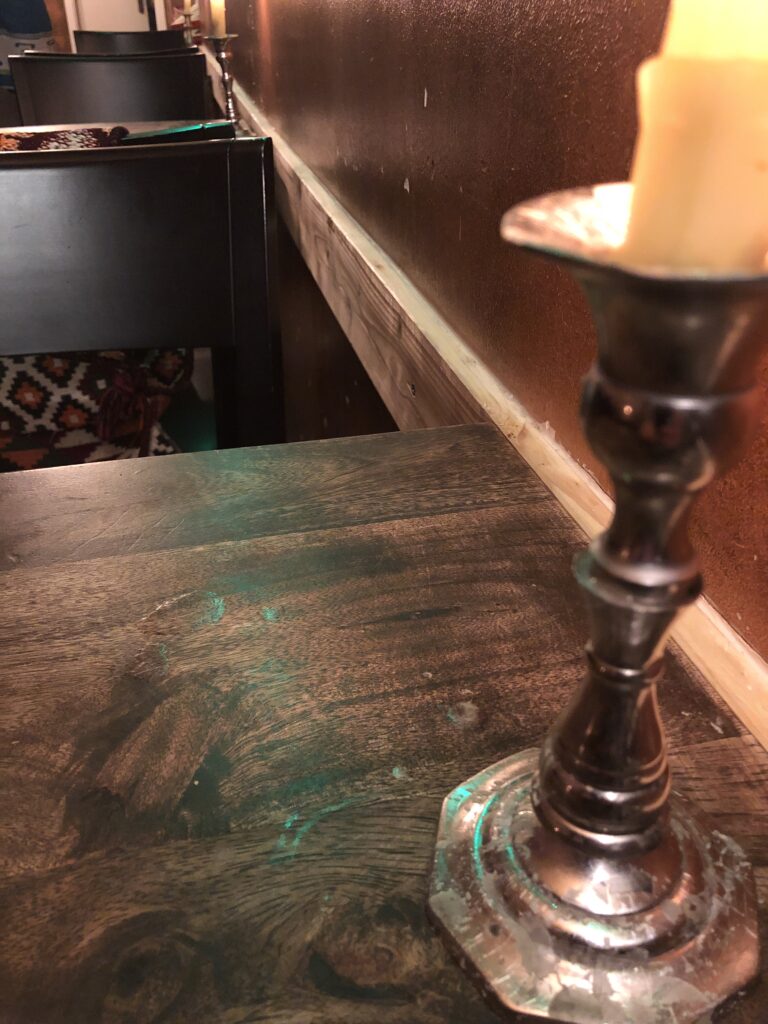
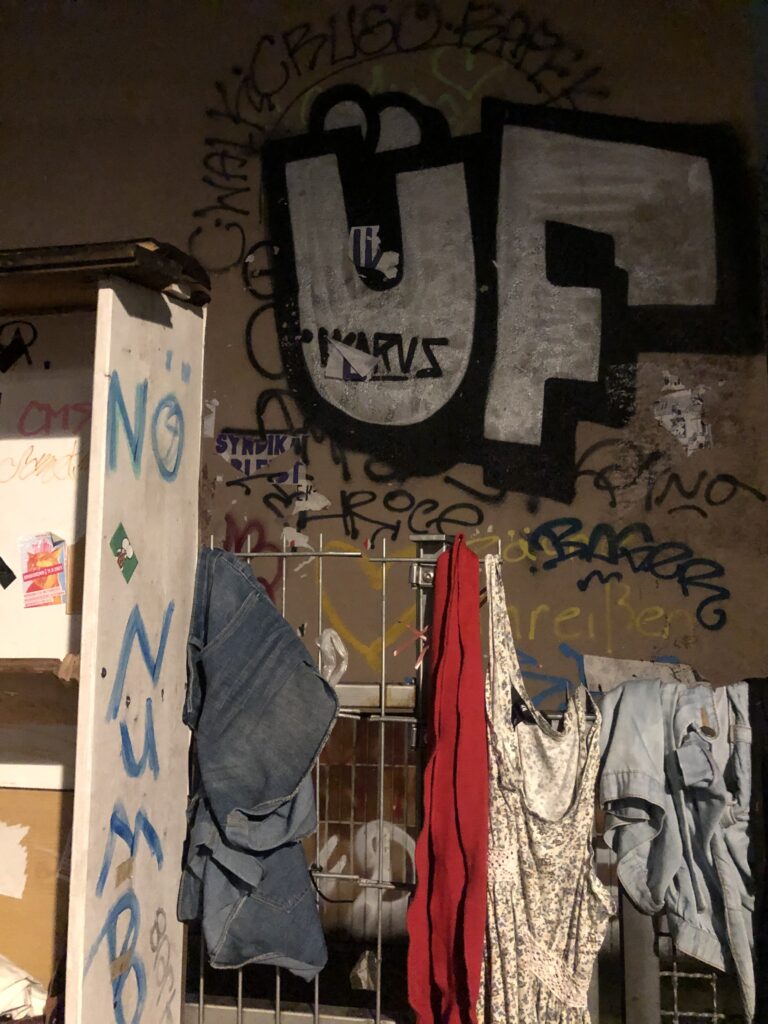
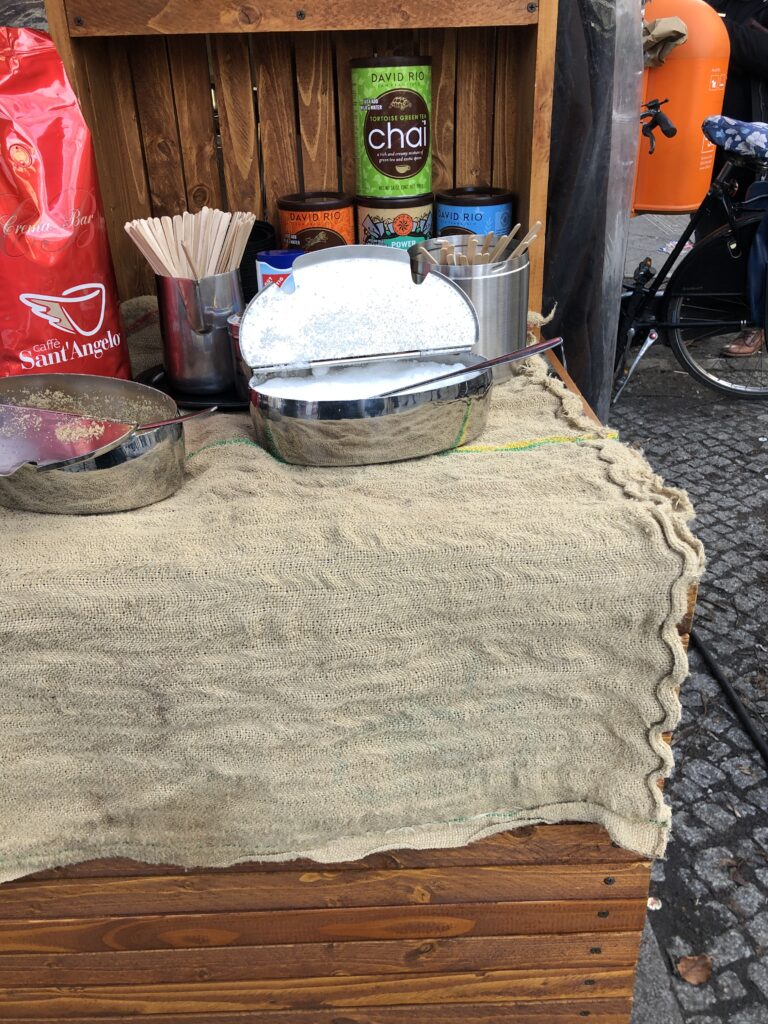
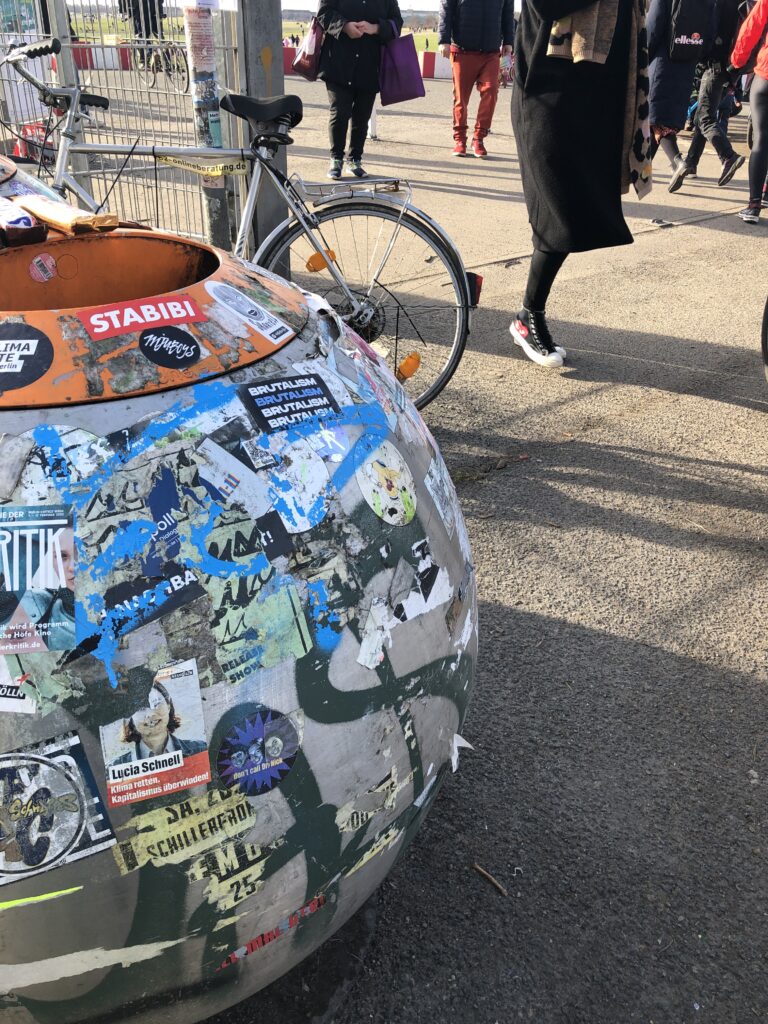
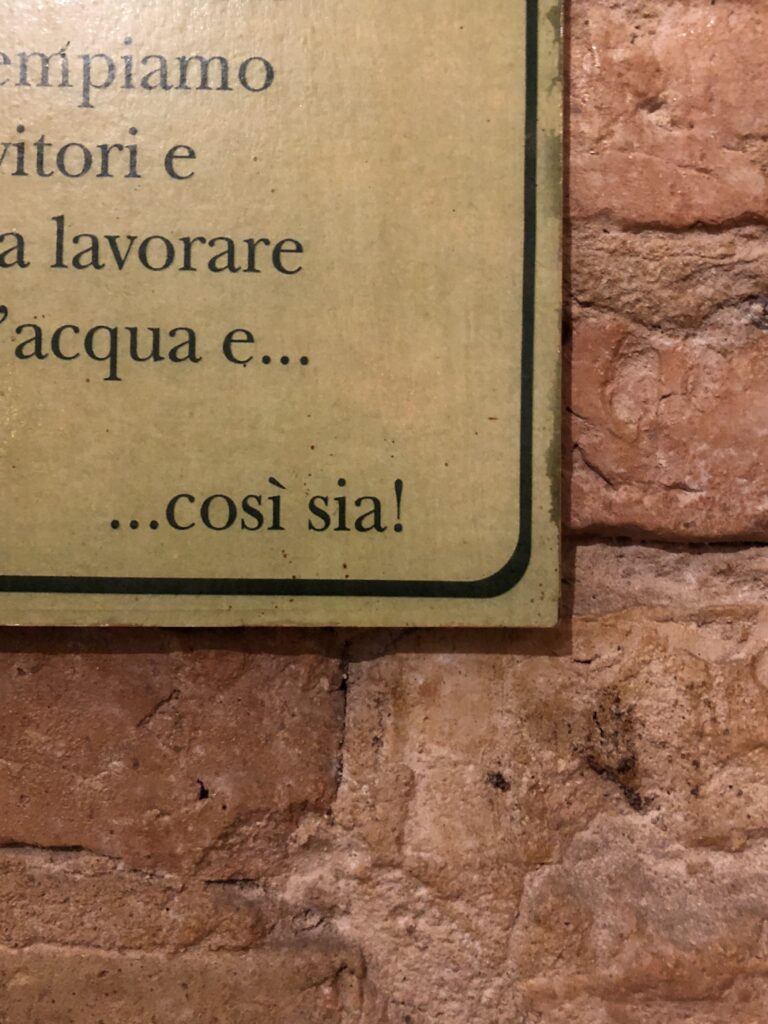
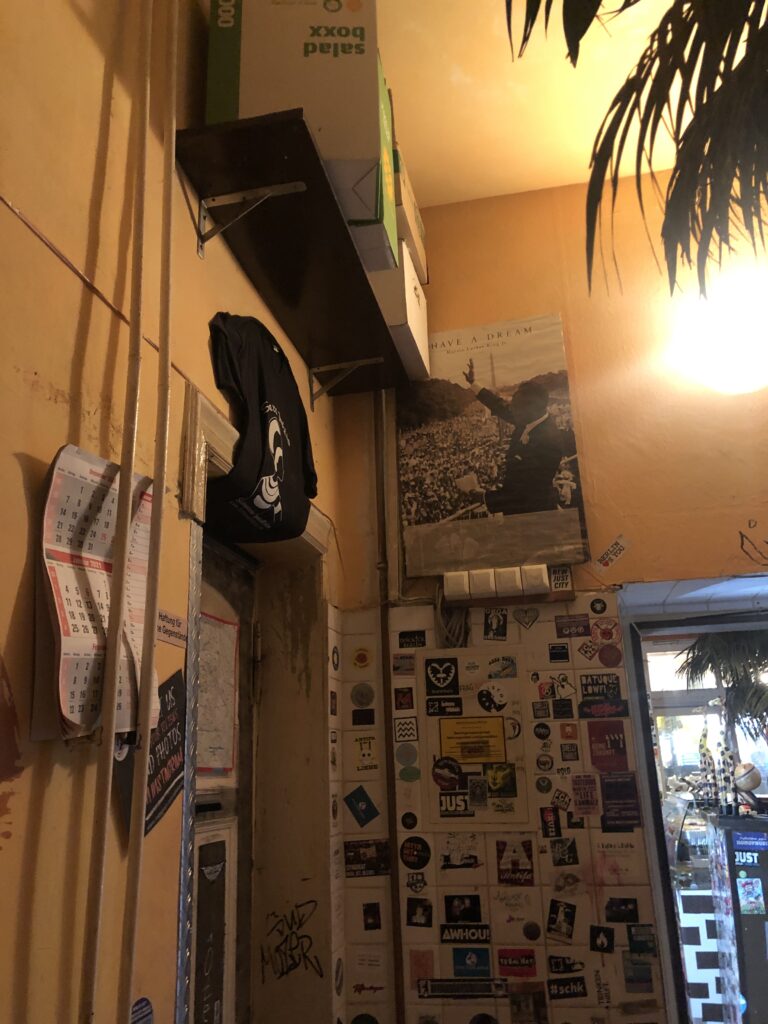
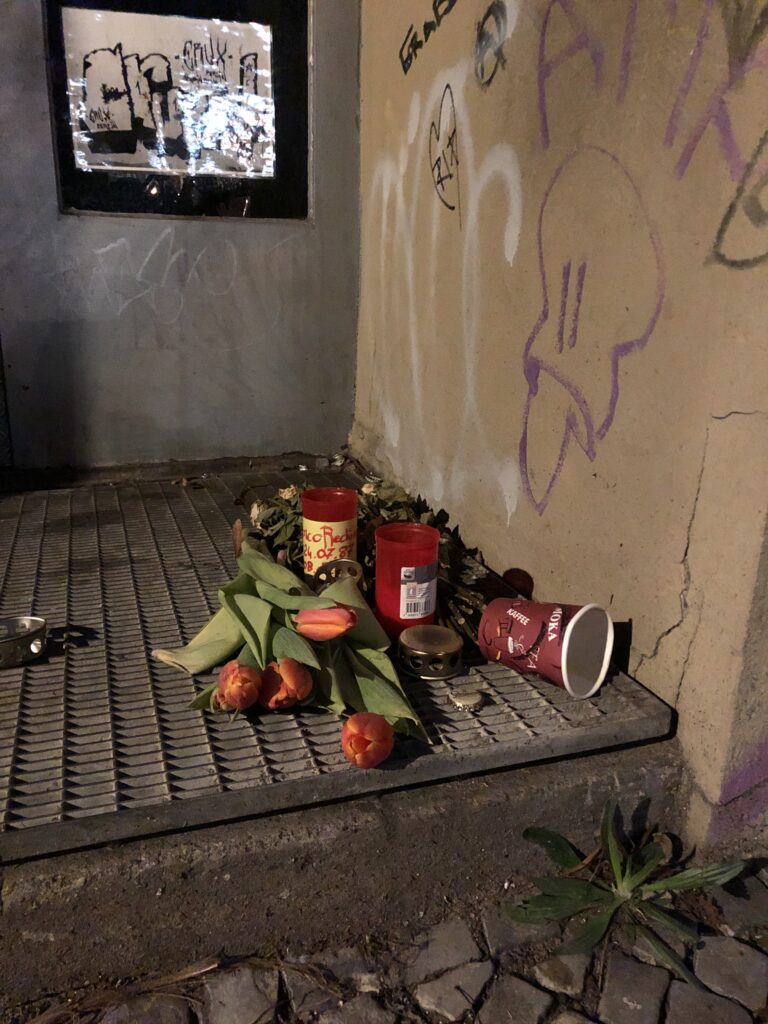
IV. Dust Covers Have a Score
Aikaterini Gegisian
V. Mapping disco comradeship in East Berlin: which places, whose voices, what traces?
Pablo Santacana López and Daniel Schneider
Departing from the conversations and inputs from the workshop Archiving Club Cultures from Late Socialism to the Era of ‘Social Distancing’, this work-in-progress cartography traces some of the main locations related to nightlife, clubbing and youth culture in East Berlin prior to the fall of the wall in 1989. In the context of late socialism, ‘club cultures’ existed in a variety of locations and formats, from punk concerts in protestant churches and official youth centers to dj sets in opulent cafés and restaurants, including one of the first protoraves at one of East Berlin’s main sports arenas. The variety of locations challenged the limits of officiality, state regulation and illegality. Their account haunts the narration of the many subcultures already active in east Berlin before the reunification. For instance, in 1987, the Zionskirche in Mitte was the location of a punk concert violently attacked by a group of neonazis that previously gathered in the Jugendgastätte Disco Sputnik (Greifswalder Str. 204). Meanwhile, the area surrounding the Eberswalder Straße train station was where the LGBT+ community gathered in what was called the Bermuda Dreieck, as homosexuality was officially allowed earlier in East Germany than in West Germany.
At the moment, the actual cartography shows just a small overview of GDR locations in Berlin. The information is taken from different kinds of sources, such as books, films and press cutouts from the and information found on websites.
The cartography is proposed to work as a collaborative map, ongoing and open for modifications. More locations, more stories and more connections between different places are to be added, mapping the activities of different youth and subcultural scenes. Also, new categories are to be added, including squatted buildings (which existed in Prenzlauer Berg before the wall came down) or open air locations where young people gathered around parties and concerts. The cartography will also work to map the actual status of each location and their visible traces in today’s Berlin.
VI. A Conversation about Trees in East Berlin
Sterre Barensten
This contribution is published in the framework of the Whole Life Academy as part of the workshop “Archiving Club Cultures from Late Socialism through the Era of ‘Social Distancing’”.
Connected Material
Schaber’s contribution revisits her 2004 work culture is our business and considers the complex issues around these three agencies. At stake in these differences are how the image’s story should be told, and how this telling is embedded in the viewing and understanding of history.
An aural and visual essay that overlays several journeys, a sensory one that attempts to evoke a perceived time, place or geography through the mapping of territories, and a narrative one materialized as a speculative epistolary correspondence between the present and the future that continuously summons the past.
Archives are often perceived as somewhat static. They look back, they conserve, they remember. But the thinking that was present in the pieces of the Pinkus Archive all addressed ecology, extinction, and political agency in ways that not only extend into our present, but into our future.
Epistolary narrative, dialogism, intertextuality, speculative narrative — we imagine this text to be letters between the two of us across different temporalities, making use of a speculative and fragmented narrative in line with the themes we explore in our work: archiving the unarchivable, emotions, memories, and other human conditions within the horizon of extinction.
Chto Delat’s installation Canary Archives employs the imagery of the canary in the coal mine, once used to alarm miners when carbon monoxide levels rose. Where is the canary today, that tells us wether the danger is real? It seems to have gone silent, the sharpest signal it can send. In an emergency newspaper issue under the impression of the Russian war on Ukraine, Chto Delat assembles anti-war views of artists and critics and expresses their solidarity with the Ukrainian people.
A conversation about KANG Sang-woo’s film KIM-GUN and how it treats historical evidence and testimonies as a ‘horizon of contingent truths’ with the potential to be pieced together in alternating ways, touching upon the complex dynamics of archives and life stories, collective memory and amnesia, the mechanisms of image-making and history-writing.
The legacy of anti-colonial leader and Pan-Africanist revolutionary Amílcar Cabral (1924-1973) still calls for cultural readings, and not strictly political ones. Contemporary art, so-called “artistic research” and critical theory will benefit from a cross-disciplinary approach which puts Cabral as relevant to art or which turns Cabral’s many contributions into tools.
Three videos are used in real time composition to explore the combination of the moving images – the edited sequence creates a non-existing-place.
This video interweaves the mobility of defiance against national-colonial borders and the collection of gossips by Southeast Asian migrants in Berlin.
The video explores the encounter (digital and analogue) between the body and the archive.